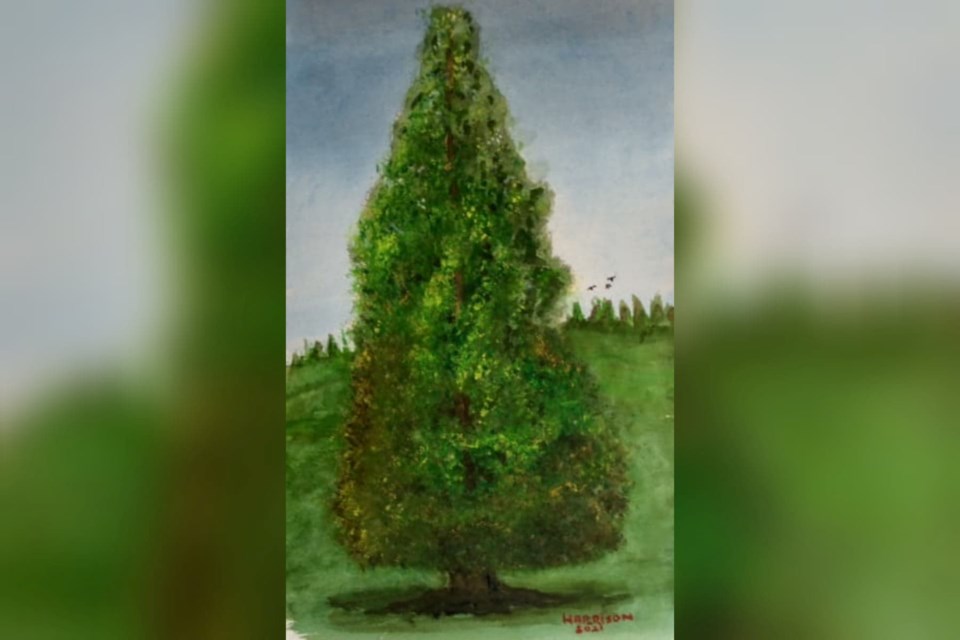**This story has been corrected since first being published to state that Ernie Harrison joined the Royal Air Force after WWII in 1946, not during the war, and that he served in the Auxiliary Fire Service as a teenager in WWII, and to update details of his time in the RAF.
Over the last month, many North Shore residents have been rallying to try and save a beloved cedar tree from being cut down to make way for a new development in the City of North Vancouver.
While 93-year-old resident Ernest "Ernie" Harrison isn’t exactly one of the protesters, he’s done his part in a different way.
The Second World War veteran is pretty handy with a paintbrush, so when his friend Shari Nelson, whom he’d met 15 years ago while taking sculpture art classes at Capilano University, asked him to paint a tree close to her heart he was happy to oblige.
The painting is of the now "famous" cedar tree on the corner of 21st Street and Eastern Avenue in Central Lonsdale, which was slated to be cut down mid-March to make way for the redevelopment of the Harry Jerome Neighbourhood Lands.
Nelson is among the nearby residents who has been protesting to protect the tree, which the community estimates to be 205 years old. When she and others discovered it was destined to be destroyed, they quickly came together and organizing petitions and protests to save their much-loved community conifer. The developer, Darwin Properties, has since changed its tune and has held off having the tree felled “in response to community concerns” and is now trying to find a solution to preserve it.
As for Harrison, the particular cedar tree doesn’t have much meaning to him, and he isn’t much interested in being part of any protests these days.
“Over my life, I've spent my time protesting and I'm not interested in any protests now,” he chuckled.
Although, he said he enjoyed nature in general and loved taking his daily strolls through Princess Park, as he lived close by, so he could appreciate why the community would want to save their urban giant.
“The trees in Princess Park are beautiful,” he said. “I know my favourite tree is a Douglas fir, they’re just huge.”
Harrison said his passion for painting came later in life, but he’d always been artistic. His story for how he got involved in the arts, firstly photography, stems back to his time as an instrument technician at Royal Air Force Marham in Norfolk, England, which he joined in 1946 after serving in the Auxiliary Fire Service as a teenager in the Second World War.
“When I was in the air force, I helped a guy, who slept in the bunk under me,” Harrison recalled. “I helped him with teaching people, about 20 or 30 people, who couldn't read or write. I just gave him a hand in the evenings when I wasn't flying.”
Harrison said the leading aircraftsman ended up leaving because he was promoted to wing commander in charge of education for bomber command. However, he later stopped by and thanked Harrison for his efforts and gave him a government grant to use towards his studies. After leaving the air force, Ernest flew a Tiger-Moth aircraft, which he owned with his brother and eight others. He'd later use the grant to go to art school and study photography.
Harrison went on to teach photography at Kodak in London, England, and later moved to Toronto, Canada, to work in studios before eventually winding up in Vancouver, where he helped open a studio called Commercial Illustrators.
While he made a living from photography most of his life, Harrison said “he could always draw.”
“My elder brother could also draw,” he said. “So, we would draw together. I’ve always been artistic in some way.”
When he retired, around 25 years ago, he said he still enjoyed taking photographs, but he couldn’t get them printed the way he wanted them, so he started using his photos as inspiration for paintings instead.
He’s continued the hobby ever since, taking various art classes.
Nelson said she’d stayed in touch with Harrison over the years via email, as he sends updates of his artworks, writing, and photography, and she’d also bumped into him here and there on the North Shore.
In the past, Harrison had painted a picture of Greece for Nelson after a holiday she’d been on, so when the cedar tree issue arose she thought painting the tree would be a nice project for Harrison, while he was trying to keep busy at home during the COVID-19 pandemic.
“He didn’t even know what it was about, but I knew he could appreciate it because he loves nature,” Nelson said.
“When he painted it, he said, ‘I think it should be surrounded by greenery, it should be out in the wild, or in a pasture,’ so he painted it green all the way around.”
She said Harrison’s painting, while it wasn’t an exact depiction of the tree’s location, highlighted that the tree “still has lots of life, and it looks happy.”
“I like to think of it as, the tree is happy where it is now, and it should stay there,” Nelson said.
“It just brings that bit of Mother Nature to the city, which is so vital to life.”
She said so far the painting had been used to help raise awareness of their group Save Our Cedar’s cause and it would later be sold to someone who “had a special feeling for it,” or auctioned off.
While the cedar tree’s prospects are now looking positive, if anything should take a turn, the beautiful conifer will live on in the painting.
More of Harrison’s artwork can be found at Giftworks Boutique at Edgemont Village.

.png;w=120;h=80;mode=crop)


